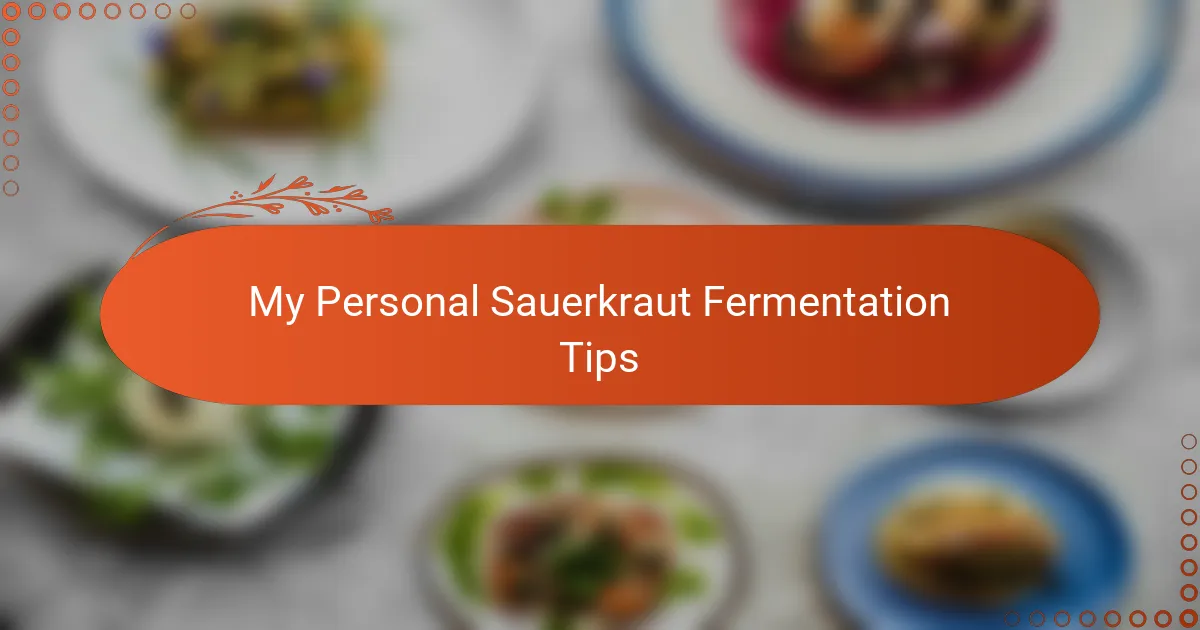My Experience with Fermenting Sauerkraut at Home
- Sauerkraut fermentation is a natural process that transforms cabbage through beneficial bacteria, creating a unique flavor and preserving the vegetable.
- Essential equipment includes a sharp knife for slicing, a weight to keep cabbage submerged, and a breathable cover to prevent pressure buildup during fermentation.
- Choosing fresh, firm cabbage and using non-iodized salt are crucial for successful fermentation; patience is key for flavor development.
- Homemade sauerkraut is versatile, enhancing meals like sandwiches, soups, and salads with its tangy flavor and probiotic benefits.

Understanding Sauerkraut Fermentation Process
Fermentation, to me, is like nature’s quiet magic at work. When I first started fermenting sauerkraut, I was amazed at how simply chopping cabbage and salt could kickstart a process where beneficial bacteria transform that crunchy vegetable into something tangy and alive. Have you ever noticed how the smell changes after a few days? It’s the signature scent of lactic acid produced by these hardworking microbes.
Understanding that sauerkraut fermentation happens in stages helped me feel more connected to the whole process. Initially, these good bacteria consume sugar from the cabbage, creating an acidic environment that preserves the kraut and develops its characteristic flavor. It’s fascinating to think that without this natural preservation, we wouldn’t have enjoyed sauerkraut for centuries.
The beauty of this process lies in its simplicity and reliability, but also in its unpredictability—every batch can taste just a bit different depending on the cabbage’s freshness or ambient temperature. This has kept me curious and eager to experiment, turning a humble vegetable into a personal culinary adventure. Does that not make fermentation feel like a little journey you embark on right in your own kitchen?

Essential Equipment for Sauerkraut Making
When I first started making sauerkraut, I thought I needed fancy tools, but really, all you need is a sturdy mixing bowl and something to weigh the cabbage down. I found a simple glass jar works perfectly, and using a clean rock or a water-filled bag as a weight keeps everything submerged, which feels like a small ritual of care I perform daily.
One piece of equipment I quickly realized was essential is a sharp knife or a mandoline for slicing the cabbage thinly. It makes such a difference; finely sliced cabbage ferments evenly and releases more juice, which helps the bacteria do their job. Plus, there’s something almost meditative about the repetitive slicing, don’t you think?
Oh, and don’t forget a breathable cloth or a loose lid to cover the kraut while it ferments. I’ve learned that sealing the jar tightly too soon can cause unwanted pressure build-up, which was a lesson I only understood after a little explosion of sauerkraut juice in my kitchen. That moment taught me patience and respect for the fermentation process—a messy but valuable teacher.

Choosing the Best Cabbage and Ingredients
Choosing the best cabbage feels like setting the foundation for everything that follows. I’ve learned to pick heads that are firm with vibrant green leaves—anything wilted or spotted is like inviting trouble to slow down or ruin the fermentation. Have you ever grabbed a cabbage that just didn’t seem quite right and ended up with mushy kraut? That taught me to trust my eyes and hands more.
When it comes to ingredients beyond cabbage, salt is my trusty companion. I prefer using non-iodized sea salt because it keeps the fermentation pure and lets the good bacteria thrive without interference. Adding extra flavors like caraway seeds or juniper berries is tempting, but I’ve found starting simple helps me better understand the nuances of how the cabbage itself transforms.
Sometimes, the local farmer’s market surprises me with oddly shaped cabbages that look imperfect but taste incredible once fermented. That got me thinking—maybe “best” isn’t always about perfect appearance but freshness and a little bit of character. Do you ever find joy in working with what nature offers, even if it’s not textbook perfect? That unpredictability makes fermenting feel more alive to me.

Step by Step Fermentation Instructions
The first step I take is slicing the cabbage as thin as possible, then mixing it with the right amount of salt—usually about 2% of the cabbage’s weight. I remember the first time I eyeballed this and ended up with something a bit too salty, which taught me to actually weigh the salt. Do you know that salt isn’t just for flavor but is crucial in creating the perfect environment for fermentation?
Once salted, I massage the cabbage vigorously until it releases enough juice to cover itself. It feels almost like a workout for my hands, and there’s something oddly satisfying in watching the cabbage soften and the salty water pool at the bottom of the bowl. That brine is your homemade magic potion, and making sure everything stays submerged under it is the key to preventing mold.
After packing the cabbage tightly into a clean jar, I press it down with a weight to keep it submerged, then cover it loosely with a cloth or lid. I usually leave it on the counter at room temperature, checking daily for bubbles and that tangy aroma that signals fermentation is progressing. Have you ever watched that small jar daily, feeling part of an ancient tradition each time you lift the lid? It’s a simple ritual that connects me deeply to the natural rhythms of food and time.

Troubleshooting Common Fermentation Issues
Sometimes, despite all your care, you might notice white fuzzy spots forming on the surface—what I’ve learned is called kahm yeast. It startled me the first time, but after some research, I realized it’s harmless and just a sign that the environment is a bit too dry on top. Simply skim it off, ensure the cabbage stays well submerged, and keep the jar covered loosely. Have you ever panicked over something that turned out to be completely normal?
On a few occasions, my sauerkraut developed an off-putting smell—more like rot than tang. That unmistakable scent reminded me to double-check my salt ratio and cleanliness. Salt not only flavors but also protects; not adding enough or using iodized salt can let bad bacteria take over. I found that sticking to non-iodized sea salt and meticulous hygiene are my best defenses against spoilage.
Another tricky issue I bumped into was bubbles forming excessively or jars bulging too much. This usually means fermentation is running hot or too vigorous. What helped me was moving my jar to a slightly cooler spot and loosening the lid to release excess gas. Patience is key here—fermentation is alive and sometimes a bit noisy, just like any living process I’ve encountered in my kitchen adventures.

My Personal Sauerkraut Fermentation Tips
One tip I swear by is weighing down the cabbage properly to keep it submerged under its brine. I once skipped this step, thinking it wasn’t a big deal, only to find mold had started to creep in by day three. Keeping everything underwater feels like giving my kraut a cozy little blanket — it’s a small but crucial act of care that really pays off.
I also learned to trust my senses more as the fermentation progresses. Sometimes I poke around gently with a clean utensil and inhale the aroma; if it smells fresh and tangy, I know it’s on the right track. Have you ever caught yourself excitedly sniffing your sauerkraut like it’s a secret treasure in a jar? That moment always connects me to the process in a special way.
Lastly, patience has become my best friend during fermentation. I remember my first batch turned out somewhat bland because I rushed the timing. Now I allow at least two weeks, sometimes more, depending on the temperature and how the flavors develop. It’s amazing how simply waiting can transform a simple cabbage into something so complex and satisfying. Have you noticed how good things often require a bit of patience?

Using Homemade Sauerkraut in Recipes
Using homemade sauerkraut in recipes has become one of my favorite ways to add a burst of tangy depth to everyday meals. I love tossing it into sandwiches or burgers—it instantly lifts the flavors and adds that satisfying crunch that you just can’t get from store-bought versions. Have you ever tried it on a grilled cheese? The contrast between melty cheese and zesty sauerkraut is surprisingly delightful.
What really excites me is how versatile sauerkraut is beyond the classic pairings. I’ve experimented by stirring it into soups or stews near the end of cooking, which gives the broth a subtle acidic brightness, balancing richer ingredients beautifully. On a chilly day, that little spoonful feels like a homemade secret ingredient that warms both body and soul.
Sometimes, I even use sauerkraut as a topping on salads or as a side to roasted veggies. It’s great to think of it not just as a condiment but as a functional ingredient that brings probiotics and flavor to the plate. Have you considered how something so simple can transform a meal and support your gut health at the same time? That’s the kind of double win that keeps me coming back to making my own batch.
Source: https://thewannabehomesteader.com/my-experience-with-fermenting-sauerkraut-at-home/
Anyone can join.
Anyone can contribute.
Anyone can become informed about their world.
"United We Stand" Click Here To Create Your Personal Citizen Journalist Account Today, Be Sure To Invite Your Friends.
Before It’s News® is a community of individuals who report on what’s going on around them, from all around the world. Anyone can join. Anyone can contribute. Anyone can become informed about their world. "United We Stand" Click Here To Create Your Personal Citizen Journalist Account Today, Be Sure To Invite Your Friends.
LION'S MANE PRODUCT
Try Our Lion’s Mane WHOLE MIND Nootropic Blend 60 Capsules
Mushrooms are having a moment. One fabulous fungus in particular, lion’s mane, may help improve memory, depression and anxiety symptoms. They are also an excellent source of nutrients that show promise as a therapy for dementia, and other neurodegenerative diseases. If you’re living with anxiety or depression, you may be curious about all the therapy options out there — including the natural ones.Our Lion’s Mane WHOLE MIND Nootropic Blend has been formulated to utilize the potency of Lion’s mane but also include the benefits of four other Highly Beneficial Mushrooms. Synergistically, they work together to Build your health through improving cognitive function and immunity regardless of your age. Our Nootropic not only improves your Cognitive Function and Activates your Immune System, but it benefits growth of Essential Gut Flora, further enhancing your Vitality.
Our Formula includes: Lion’s Mane Mushrooms which Increase Brain Power through nerve growth, lessen anxiety, reduce depression, and improve concentration. Its an excellent adaptogen, promotes sleep and improves immunity. Shiitake Mushrooms which Fight cancer cells and infectious disease, boost the immune system, promotes brain function, and serves as a source of B vitamins. Maitake Mushrooms which regulate blood sugar levels of diabetics, reduce hypertension and boosts the immune system. Reishi Mushrooms which Fight inflammation, liver disease, fatigue, tumor growth and cancer. They Improve skin disorders and soothes digestive problems, stomach ulcers and leaky gut syndrome. Chaga Mushrooms which have anti-aging effects, boost immune function, improve stamina and athletic performance, even act as a natural aphrodisiac, fighting diabetes and improving liver function. Try Our Lion’s Mane WHOLE MIND Nootropic Blend 60 Capsules Today. Be 100% Satisfied or Receive a Full Money Back Guarantee. Order Yours Today by Following This Link.






